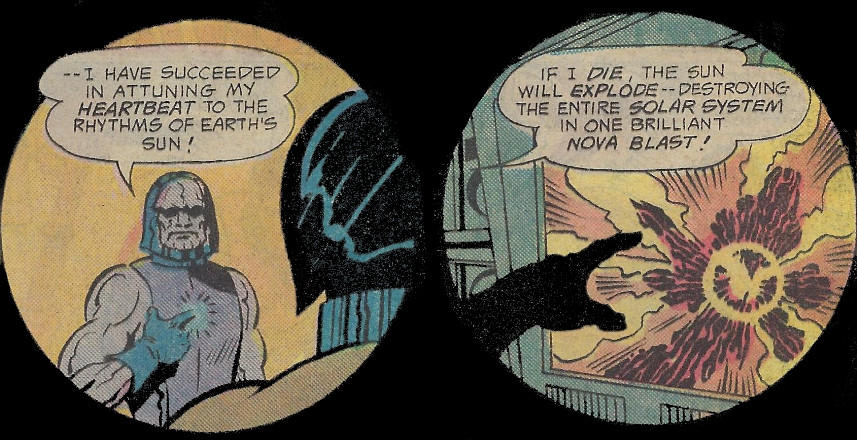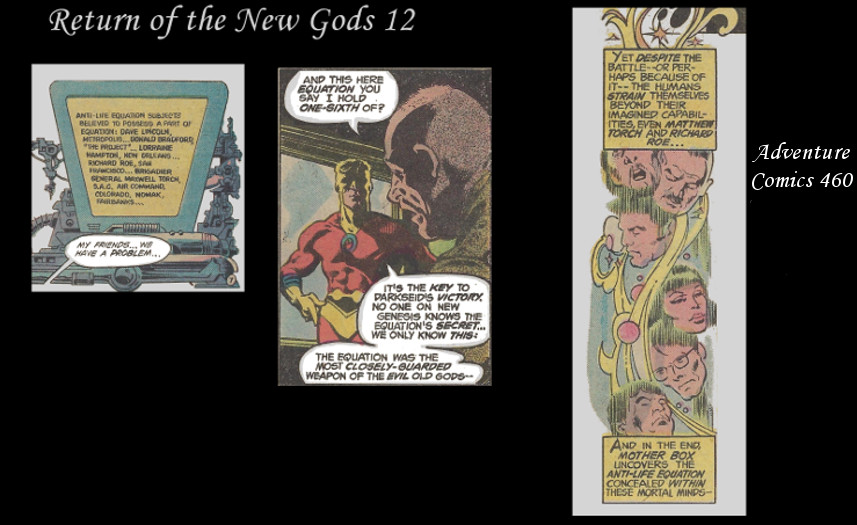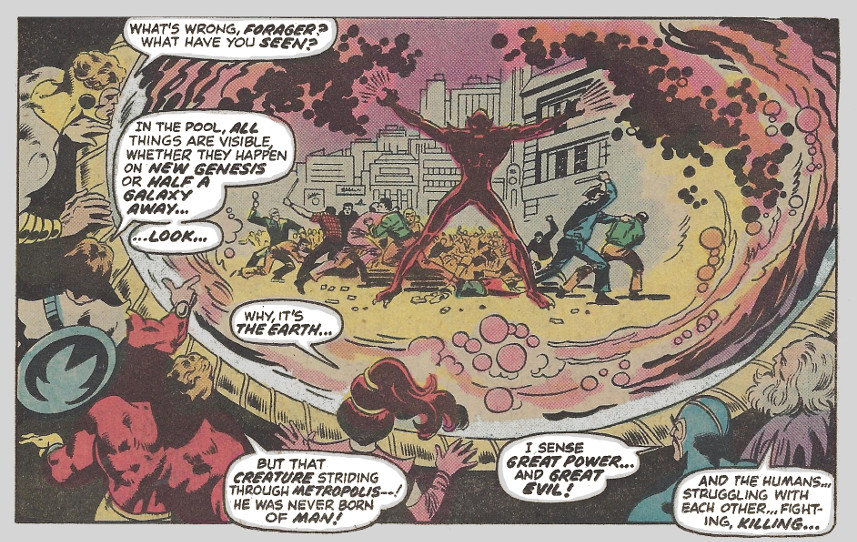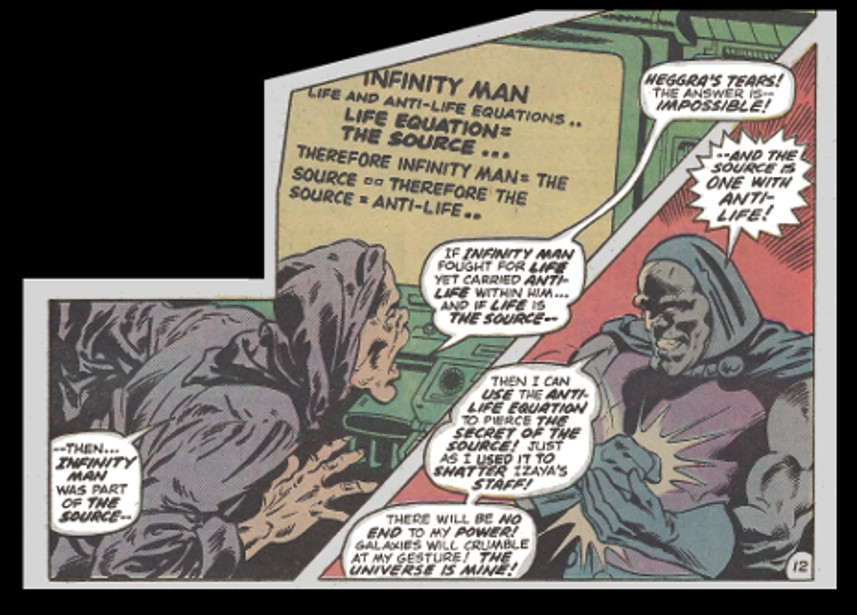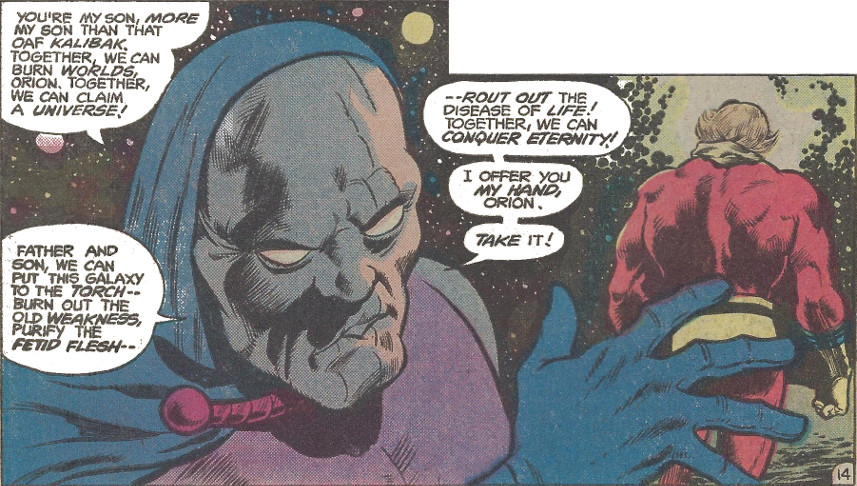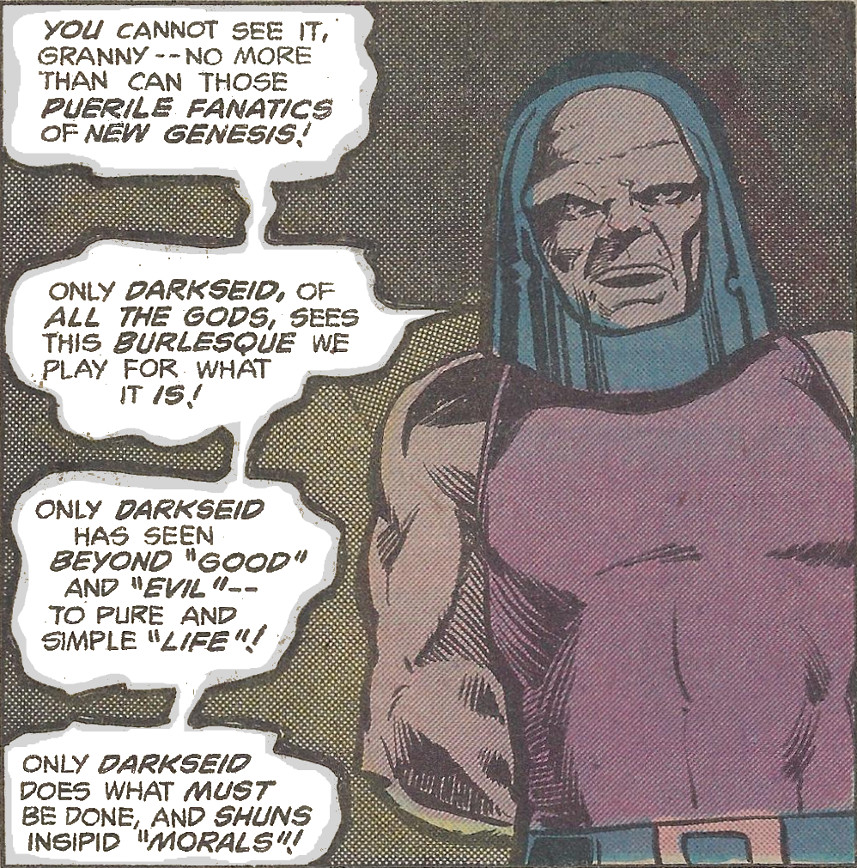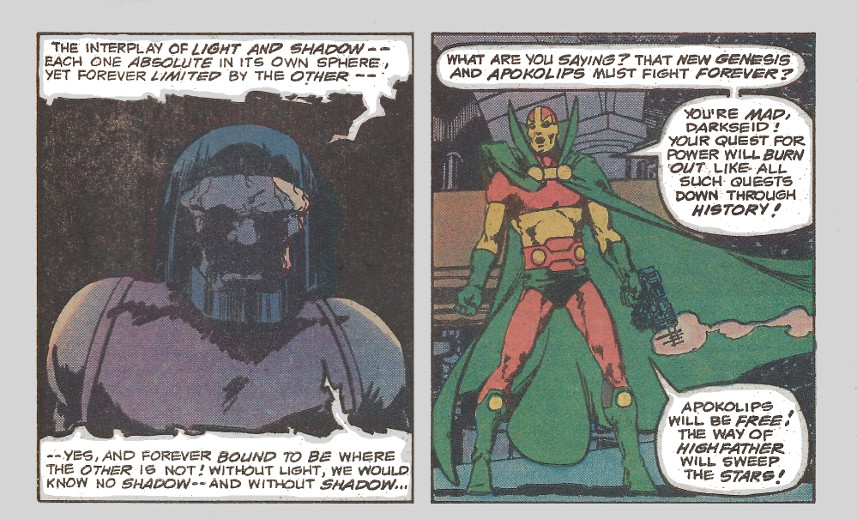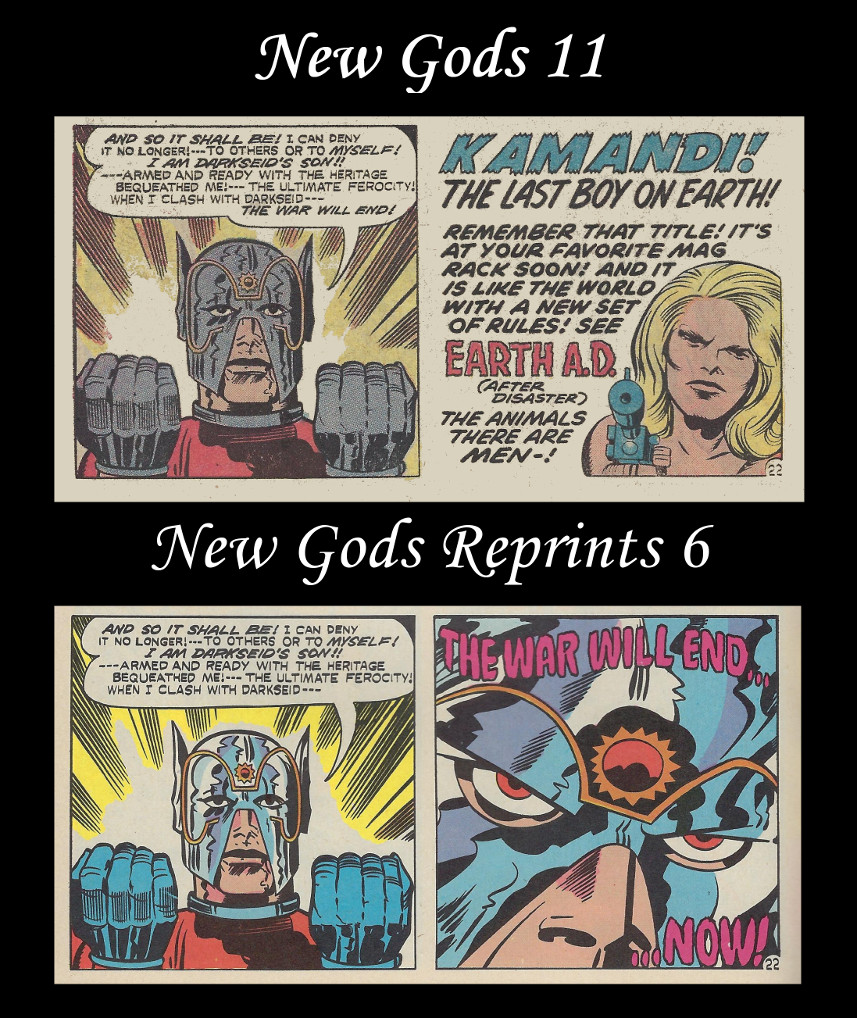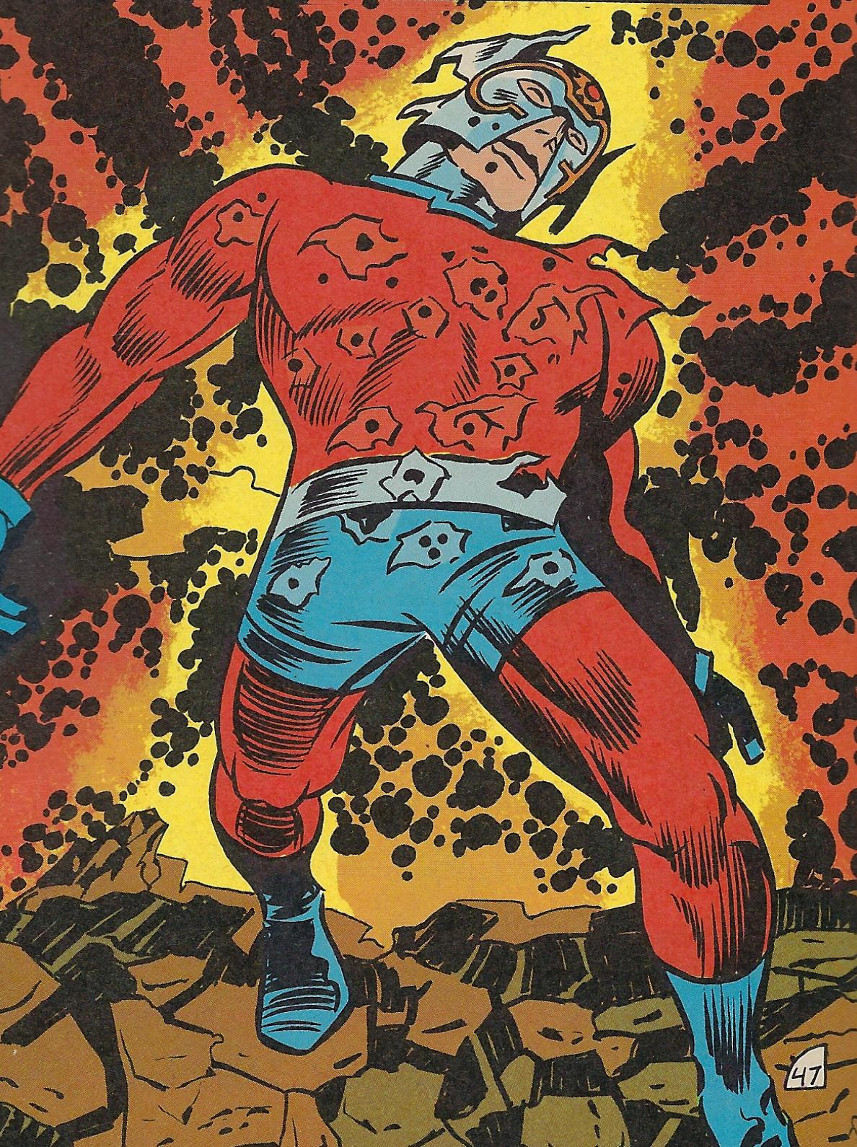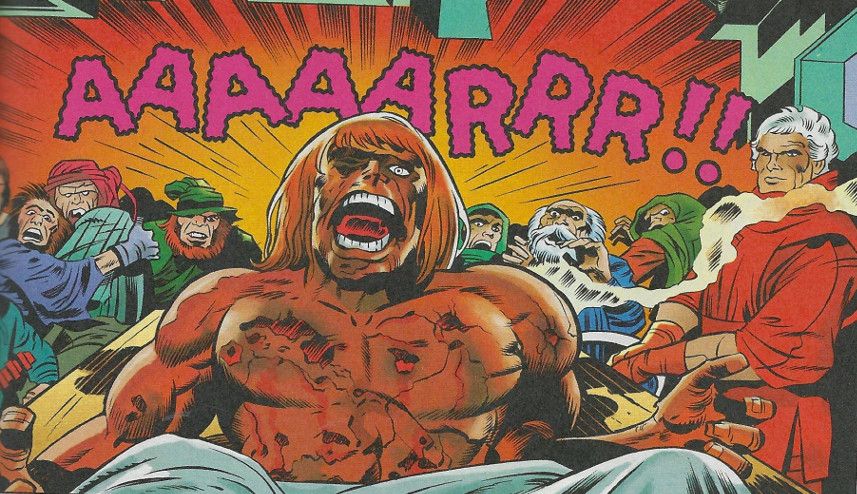Kirby started his Fourth World series with a lot of passion and hype and energy and ideas. His visual style, as always, made his art seem to pop off the page, grabbing the reader’s attention. And his mysterious language – including terms like Mother Box, New Genesis, Darkseid, the Source, Anti-Life and so on – provided a fully textured landscape for in which to set his tales. Unfortunately, his actual story-telling left much to be desired and his grand design reached a strange end; a combination of an abrupt termination in the case of the New Gods and the Forever People and a slower decline in Mister Miracle. Eventually, Kirby returned to Marvel Comics, albeit briefly, leaving his Fourth World behind.
Recognizing that there were valuable mythological elements in what Kirby had wrought, DC would try repeatedly over the intervening 40 years to recapture the original excitement and buzz. Titles would be relaunched and, for a time, draw a readership, but after a while interest would wane and the series would disappear, only for the pattern to repeat about 5 or 10 years later, usually as a result of some trigger event.
The first attempts at a revival occurred during the time span from 1977– 1987, a period which I will call the Dark Decade, and they were mostly unmemorable; the two exceptions being the fine presentation of The Great Darkness Saga in the Legion of Super-heroes and the X-Men/Teen Titans one shot crossover.
The publication timeline for the Dark Decade is interesting in and of itself and provides the first opportunity to see how the Kirby concepts get interpreted by new writers. The trigger that started the whole thing off was a new Fourth World story published in the last issue of 1st Issue Special (#13) and terminated with the Hunger Dogs graphic novel (published in 1985), in which Kirby returns for a final story intended to close out the story of New Genesis and Apokolips.
The Dark Decade naturally divides into two pieces that encapsulate the death-rebirth cycle pattern of the Fourth World. The first rebirth, spanning 1976-1978, mainly consisted of a restart of the New Gods and Mister Miracle with no break in numbering (although the cover of the New Gods routinely sported the title Return of the New Gods). These two titles lasted until the DC Implosion after which a hasty closure was put in place in Adventure Comics #459-460.
This first rebirth is particularly fascinating since it shows how the writers (particularly Gerry Conway) see that the tone and substance of Kirby’s original narrative needs to be matured. The action picks up 1st Issue Special #13, with Orion, now sporting a new costume, invading Apokolips
hell-bent on killing Darkseid and putting an end to the current war between Apokolips and New Genesis. His fury is quickly blunted when he learns that he must drop his plan of patricide and bide his time because revenge on Darkseid would have disastrous consequences. This message is delivered by the mysterious Source, which communicates via a disembodied hand writing cryptic messages on the wall as if it were straight from the book of Daniel in the bible.
Further investigation by the New Gods reveals that direct action against Darkseid would spell doom for the Earth.
These devices are a marked departure from the Kirby approach in several ways. First, Kirby had always portrayed Darkseid more as a Hitleresque-dictator bent on control but with far less physical power and potency than the version here. Second, Orion was portrayed more as a noble savage rather than a cold, calculating killer. Here, it seems, that Conway has recognized the need to make the content more grim and adult.
After nearly a year, the story continues in the restart of the New Gods at issue #12 with an obligatory nod to Kirby’s original concept
but with the narrative focused very tightly on Darkseid’s desire for the Anti-Life formula. Once held by the Infinity Man, an being called into existence by the Forever People (a set of hippy New Gods who leave New Genesis to avoid the war with Apokolips) whenever they united via their Mother Box, the Anti-Life formula (see last post) is now divided into six parts and is carried by 6 human beings
Despite the efforts of the New Gods, by the end of the series Darkseid has obtained the Anti-Life formula. This knowledge allows him to cripple New Genesis, to create a mind-controlling obscenity called the Antagonist, which he unleashes on the Earth.
It also emboldens him to dare to penetrate the very essence of the Source,
a feat many have tried but none have accomplished. Punishment for trying and failing is a kind of living death, the victim being bloated to the size of planets and chained immovably to rock – the so-called Promethean Giants
After the DC implosion end the New Gods at issue #19, Conway constructs the final pieces in Adventure Comics #459-460. Here he has a one-on-one confrontation between Orion and Darkseid, as the latter is just about to try to enter the Source. Declaring that he no longer holds Earth’s fate hostage to his own heartbeat, Darkseid instead tries to tempt Orion to join him
When Orion refuses, Darkseid savagely attacks and leaves him for dead. However, Darkseid is weakened by his battle with his son and he fails to penetrate the Source and his seemingly destroyed – although he will be brought back later in Justice League of America #183.
Perhaps more interesting are the philosophical ideas explored by Steve Engelhart and, subsequently, Steve Gerber, in Mister Miracle. Again recognizing that the original Kirby arc lacked in theme and meaning, some of the most interesting dialog happens between Scott Free/Mister Miracle and Darkseid, including Darkseid’s revelation that he alone sees the cosmic jest of their collective situation
and his suggestion that the universe is dualist in its nature
The Fourth World remained quiet for a number of years later but the critical and commercial success of both the Great Darkness Saga and the X-Men/Teen Titans crossover, retriggered a new try.
In 1984, DC reprinted the New Gods in a higher quality reprint series with two issues per publication. Since there were 11 issues in the original run, this left space of a finale in the sixth installment. DC brought back Kirby, who supplied the Even Gods Must Die story and who redrew that last panel of New Gods #11 to look as if nothing had ever interrupted the flow.
The new story places Orion back on Apokolips (just like 1st Issue Special) but with a far different outcome. By the end of this installment, Darkseid – who in Kirby’s version is to cowardly to do his own dirty work – has Orion gunned down
presumably to his death, although the body is never found. Whether the Even Gods Must Die story was meant as a tease or it was found to be unsatisfactory by the readers, Kirby followed it up with the Hunger Dogs graphic novel. The primary theme here is that Orion, saved from death his Mother Box
now becomes a rallying figure for the hunger dogs (i.e the oppressed of Apokolips).
While the Orion-back rebellion continues to foment, Darkseid abandons the Anti-Life formula once one of his scientists invents Micromark,
a small AI that ushers in an era of machines on Apokolips.
Darkseid, who Kirby again portrays more as a universal tyrant rather than cosmic villain,
and his Micromark new world era don’t last long as the Hunger Dogs rise up and overthrow him. Darkseid is forced to watch Apokolips rip itself apart as Orion escapes with his mother and bride-to-be.
The Hunger Dogs is not well-regarded and its climax is widely considered to be unsatisfying. In closing out the New Gods in his own way Kirby seems to have rejected the various interpretations provided by Conway, Englehart, and Gerber, which is a shame, since their interpretations were more nuanced than his. Kirby may have created a treasure trove of ideas and images but he was never able to properly tap into to them. And this is perhaps the single biggest point and greatest tragedy of Jack Kirby’s Fourth World – that ultimately it is a lot a style over substance.




